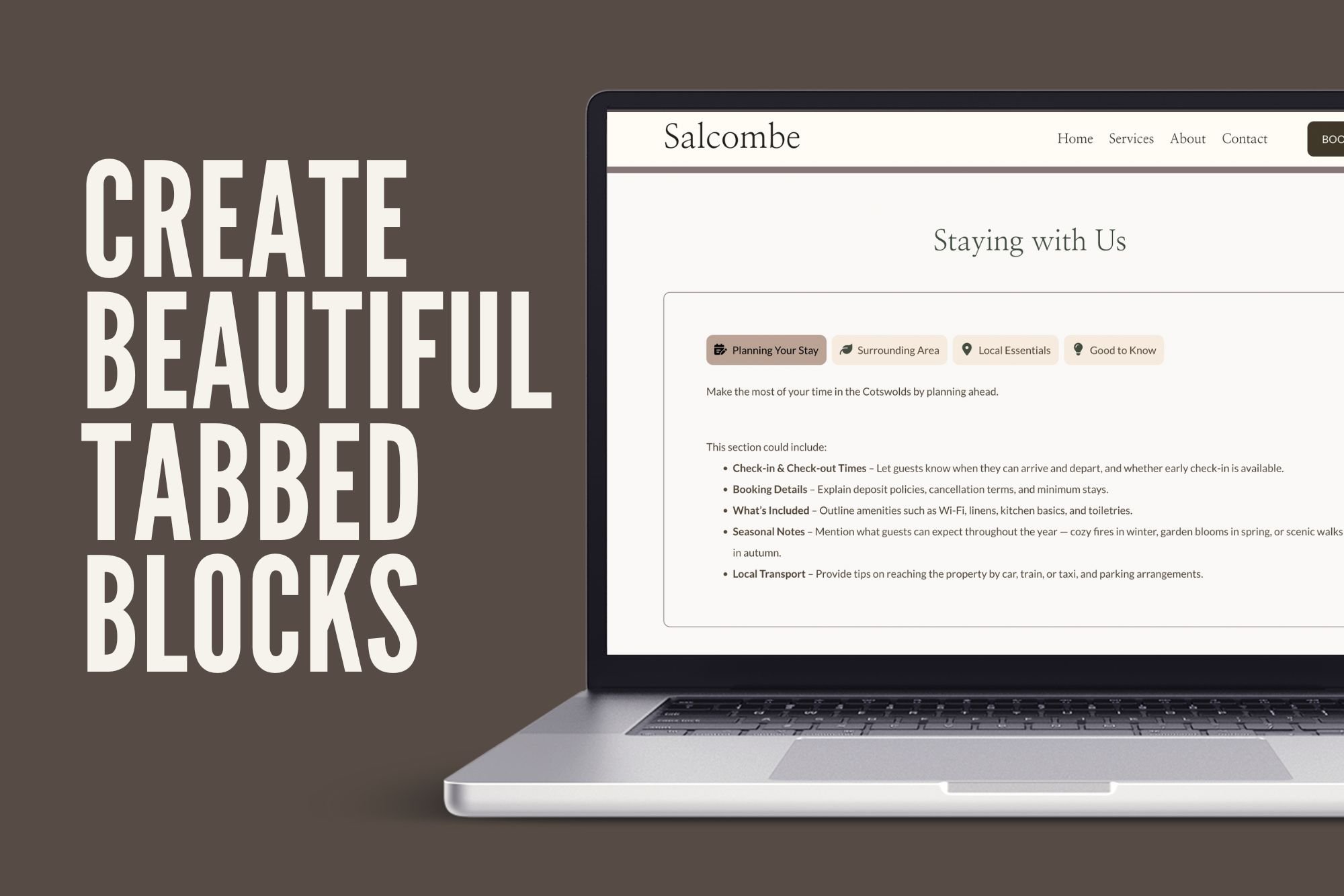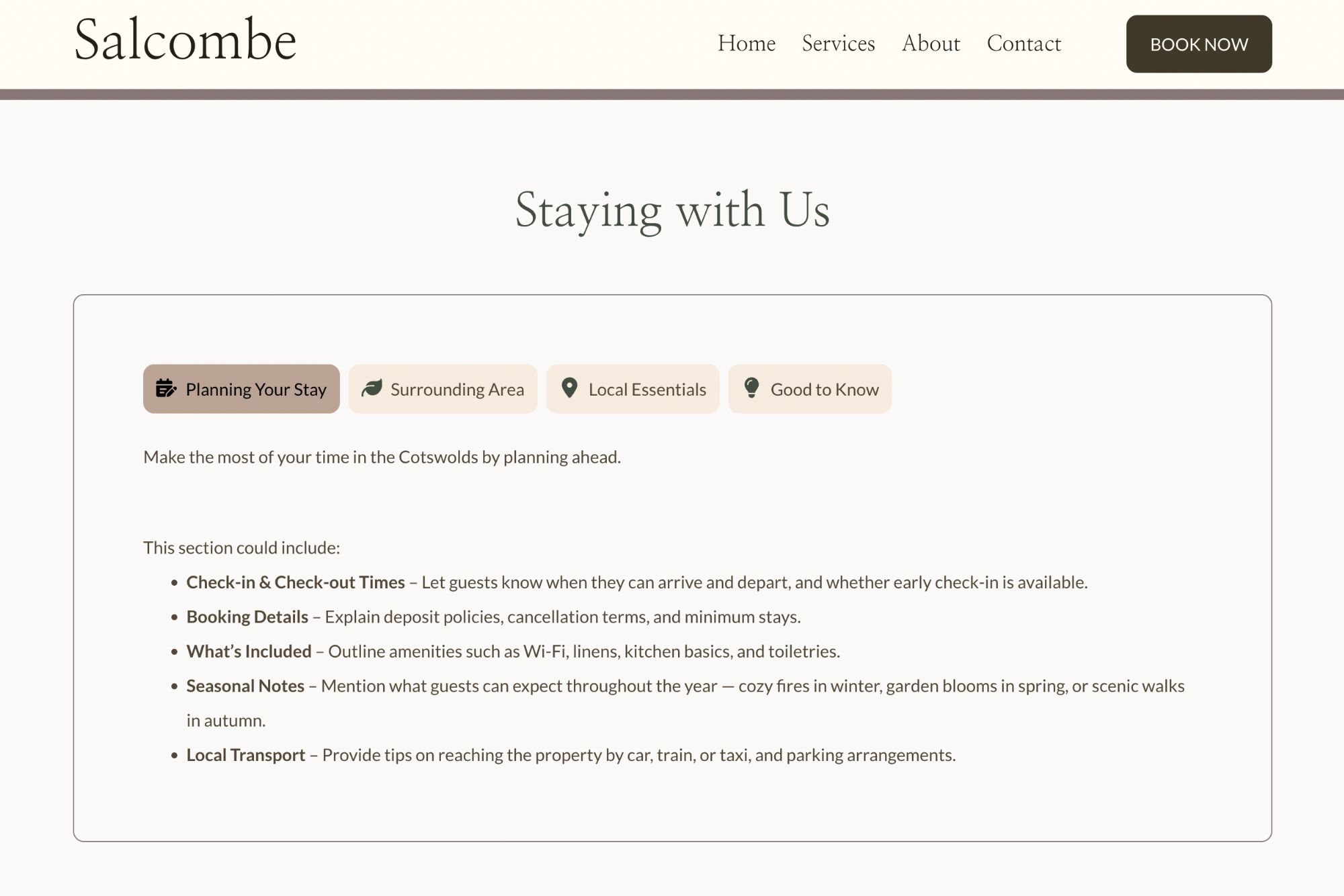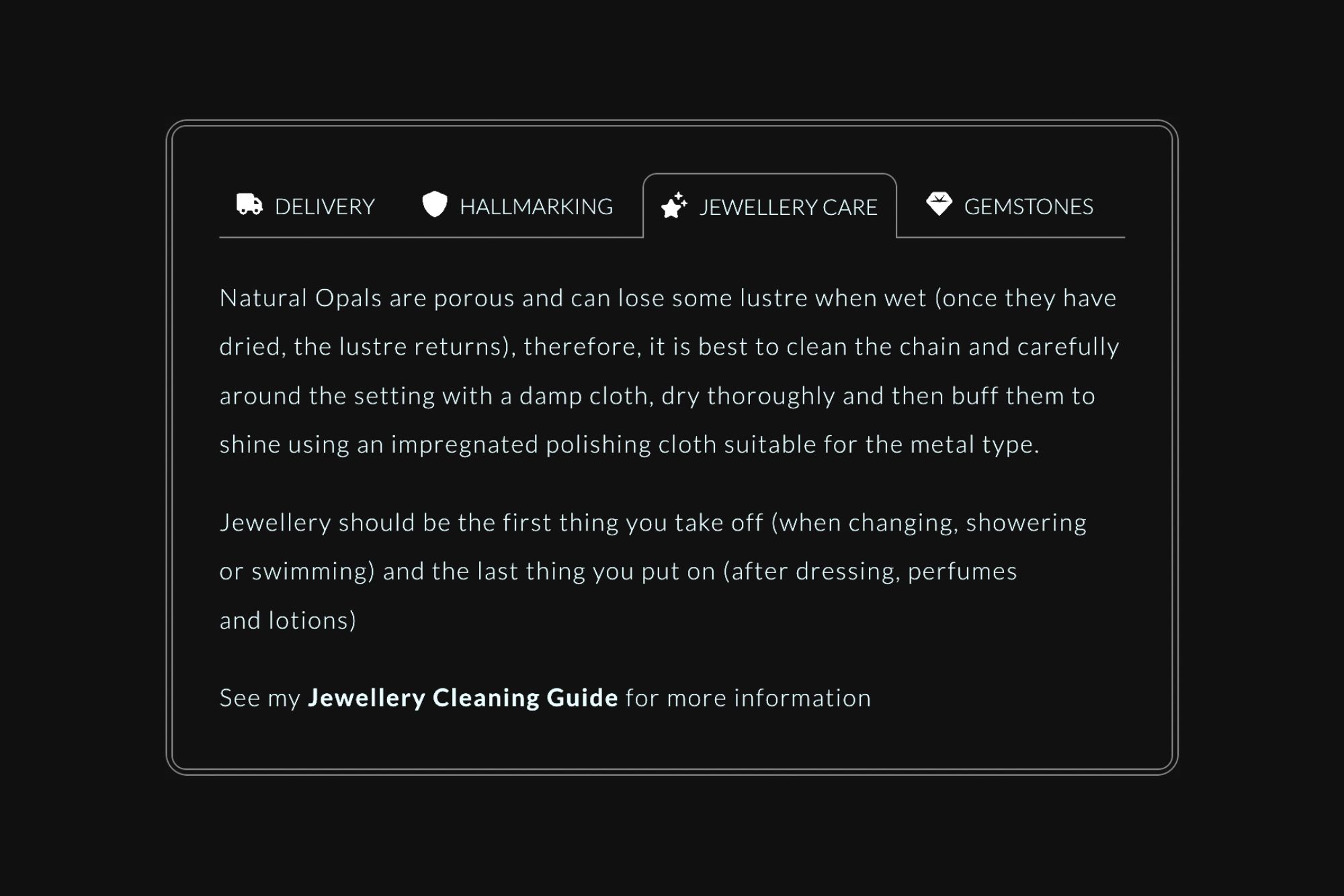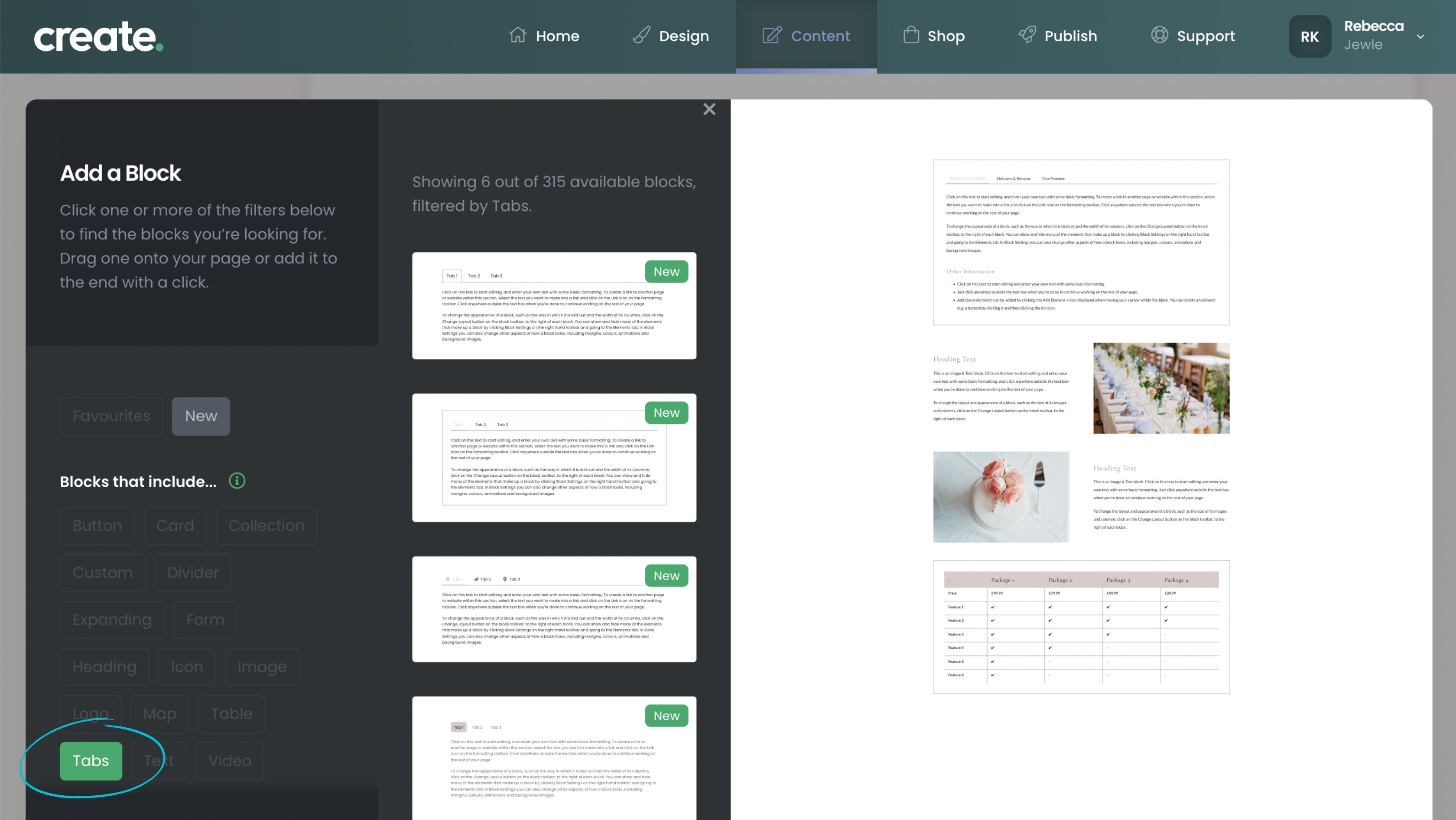Blog > Create Beautiful Tabbed Information Blocks
Posted By Create

The Smarter Way to Share Product Details
We’re thrilled to introduce one of our most requested new features: Tabbed Information Blocks — a beautifully simple way to organise content across your website and online store.
From product pages to FAQs, these new blocks make it easy to display important details in a clean, structured, and engaging format. No more long, scrolling walls of text — just neatly organised sections your customers can explore at their own pace.
What Are Tabbed Information Blocks?
Tabbed Information Blocks let you group related information into easy-to-navigate tabs. Each tab can include text, images, icons, or even embedded content, allowing you to create a seamless browsing experience for your visitors.
Tabbed Blocks let you group related information into separate, easy-to-navigate sections. Choose from a range of modern designs, icons, and layouts to match your brand’s look and feel.
Whether you’re selling artwork, handcrafted jewellery, homeware, fashion, or digital products — tabs help you share everything your customers need to know, in a way that feels effortless.
You can choose from a range of modern layouts and styles, all designed to look great on any device and fit naturally with your existing website design. Whether you want a minimal look or something more decorative, there’s a tabbed layout to suit you.

How You Can Use Them
There’s so many ways you can use Tabbed Information Blocks, here’s just a few to get you thinking and feeling creative about how to use them:
Products
Tabs help keep long or detailed product descriptions tidy and scannable. They make information more digestible and reduce the need for endless scrolling. This improves the mobile experience and conversion rates.
Description – for product story and key features.
Specifications – materials, dimensions, ingredients, or technical info
Care Instructions – cleaning, storage, maintenance
Delivery & Returns – shipping details, return policy, and timeframes
Customer Reviews – user-generated feedback without overwhelming the main page
Categories or Collections
Many designers use tabs here to give shoppers useful context or guidance. Tabs help balance storytelling with functionality, keeping pages focused while still offering depth.
Buying Guides or How to Choose sections
Brand Stories or Collection Highlights
Styling Tips for fashion, jewellery and homeware collections
FAQs specific to that category (e.g., “How to measure ring size”)
Information Pages
Tabbed layouts can transform dense pages into clear, easy-to-navigate sections. They make information easy to find and prevent overwhelming visitors with large blocks of text.
About Us – Company history, mission, and team profiles
Customer Service – Contact info, help topics, and order tracking
Policies – Returns, Privacy, and Terms, grouped neatly under one header
FAQs – Organised by topic (orders, shipping, accounts, etc.)
Resources
Businesses with more detailed content can use tabs to break up complex information. You can create a way for your visitor to engage and explore your information without feeling overwhelmed. This builds trust through their visit as they are choosing what they find out more about.
Jewellery Care, Gemstone Details, or Material Guides
Display Upcoming Events while reducing the need to scroll
Technical Documentation or User Manuals
Recipes, Tutorials, or How To Articles organised by type or level
Featured Customer : Street Craft Creations
We’re delighted to showcase an example from Street Craft Creations. Jewellery Designer Shelley has beautifully integrated Tabbed Information Blocks into her online store.

Her design features tabs for Delivery, Hallmarking, Jewellery Care, and Gemstones are a perfect demonstration of how this feature can bring structure and elegance to detailed product information.
A huge thank you to Shelley of Street Craft Creations for allowing us to share her design in this article. Please visit her website to see Tabbed Information Blocks in action and explore how they are being used to enhance her product pages.
Best Practices for Using Tabbed Information Blocks
Whilst every audience is different, some studies have been conducted on using Tabbed Information and we want to ensure you get started on the right footing. When you create your tabs follow these five principles to ensure your tabs not only look great, but also improve the browsing experience and support confident purchase decisions
1. Start Simple
Tabs work best when each one contains related information that supports a single goal. For example consider how the tabs can help your customer to decide to buy and choose between 3-5 tabs. Too many tabs can feel overwhelming and make key content harder to find.
2. Use Clear, Descriptive Labels
Each tab should have a single, easy-to-understand focus. Research shows that clear labs on your tabs will help customers find what they're looking for quickly and confidently. Instead of generic labels like “More Info” or “Details”, use meaningful ones such as “Delivery & Returns”, “Jewellery Care”, or “Materials & Hallmarking.” Your customers should never have to guess what information is going to be in a tab.
3. Lead with What Matters Most
Not everyone will click through every tab, or read the information in them so ensure your most important details appear in the first or default tab. If something is critical to the buying decision, don't hide it behind the second tab. Consider what your potential customer needs to see at a glance and display it front and centre.
4. Consider Your Mobile User
Tabs save space beautifully on desktops, but smaller screens can make it trickier for customers to navigate. Ensure you check how your tabbed sections display in a clear way or consider switching to an FAQ Accordion block layout instead. This works best where you need to have long tab titles as the sections display in a stacked layout.
5. Keep the Design Consistent
A consistent look helps customers recognise your tabbed content immediately and builds trust in your design. It's best to maintain the same design styles across your product pages or website so spend time choosing which of the ready-made designs best fit your brand. When you make your choices keep in mind readability, and ensure your tab text and background contrast colours meet accessibility standards.
How To Get Started
Ready to give your content a clean, professional new look? Adding Tabbed Information Blocks is simple and they’re available now in your website editor, just like any other content block. Here’s how to add yours now:
Open the page or blog post you’d like to edit.
Click + Add Block where you want your tabs to appear.
In the block selector choose Tabs in the Blocks That Include... filter
Choose from the range of different layout and style options you can preview before adding.
Click on the design you'd like to use and it will be placed into your page.
Adjust your tab headings, choose icons and add your content.
Tip: Try using tabs for sections like Delivery & Returns, Care Instructions, FAQs, or Materials & Craftsmanship.

We hope you enjoy exploring these new blocks. If you've got any questions, your Account Manager is always happy to help you make the most of your website.

